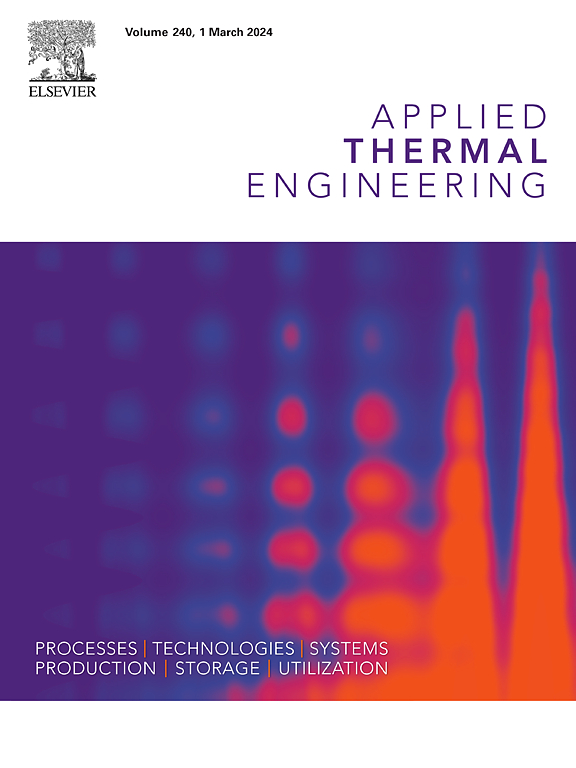Framework for prediction of two-phase R-744 ejector performance based on integration of thermodynamic models with multiphase mixture CFD simulations
IF 6.1
2区 工程技术
Q2 ENERGY & FUELS
引用次数: 0
Abstract
Current computational models of two-phase R-744 ejectors require defined outlet pressure conditions for convergence, this brings a strong dependence on experimental data or pre-guessed outlet pressure values. This study presents a framework combining a thermodynamic model and a computational fluid dynamics (CFD) model to predict two-phase R-744 ejector performance, minimizing reliance on experimental data or guessed outlet pressure values. The proposed framework is developed in a broad operating range with 137 different experimental cases from the motive inlet pressure of 51.9 bar to 101.1 bar. Three different approaches are developed for the thermodynamic model in the MATLAB environment; i) a model with global coefficients which are unchanged for the entire operating range, ii) a model with local coefficients, which have unique values for each experimental case, and iii) a model with predicted-local coefficients, which uses a prediction algorithm to find the local values for each experimental case. The local and predicted-local coefficient approaches estimate the mass flow rate from the motive inlet with a relative error of 5 %. However, the mass flow rate predictions from the suction inlet showed high deviations above 30 % for the predicted-local coefficient approach in transcritical operating conditions, while the local coefficient approach keeps the relative error still lower than 5 %. All approaches estimated the ejector outlet pressure with less than 10 % error, which is an acceptable error; therefore, the thermodynamic model-based outlet pressure was defined as the outlet boundary condition to the CFD domain. All thermodynamic model embedded CFD simulations computed the temperature and Mach number values with less than 1 % deviation at the motive nozzle exit. The results show that the prediction algorithm can estimate the ejector outlet pressure within an acceptable deviation range, offering a promising direction for future research to reduce dependence on experimental data.
基于热力学模型与多相混合物 CFD 模拟相结合的两相 R-744 喷射器性能预测框架
目前的两相 R-744 喷射器计算模型需要确定的出口压力条件才能收敛,这就对实验数据或预先猜测的出口压力值产生了强烈的依赖性。本研究提出了一个结合热力学模型和计算流体动力学(CFD)模型的框架,用于预测两相 R-744 喷射器的性能,最大限度地减少对实验数据或猜测出口压力值的依赖。所提议的框架是在从 51.9 巴到 101.1 巴的动机入口压力的 137 个不同实验案例的广泛操作范围内开发的。在 MATLAB 环境中为热力学模型开发了三种不同的方法:i) 全局系数模型,在整个工作范围内保持不变;ii) 局部系数模型,在每个实验案例中都有唯一值;iii) 预测局部系数模型,使用预测算法为每个实验案例找到局部值。本地系数法和本地系数预测法对发动机入口质量流量的估计相对误差为 5%。然而,在跨临界工作条件下,预测-局部系数法对吸入口质量流量的预测偏差高达 30% 以上,而局部系数法的相对误差仍低于 5%。所有方法对喷射器出口压力的估计误差都小于 10%,这是可以接受的误差;因此,基于热力学模型的出口压力被定义为 CFD 域的出口边界条件。所有嵌入热力学模型的 CFD 仿真都计算出了动机喷嘴出口处的温度和马赫数值,偏差小于 1%。结果表明,该预测算法可以在可接受的偏差范围内估算喷射器出口压力,为今后减少对实验数据的依赖提供了一个很好的研究方向。
本文章由计算机程序翻译,如有差异,请以英文原文为准。
求助全文
约1分钟内获得全文
求助全文
来源期刊

Applied Thermal Engineering
工程技术-工程:机械
CiteScore
11.30
自引率
15.60%
发文量
1474
审稿时长
57 days
期刊介绍:
Applied Thermal Engineering disseminates novel research related to the design, development and demonstration of components, devices, equipment, technologies and systems involving thermal processes for the production, storage, utilization and conservation of energy, with a focus on engineering application.
The journal publishes high-quality and high-impact Original Research Articles, Review Articles, Short Communications and Letters to the Editor on cutting-edge innovations in research, and recent advances or issues of interest to the thermal engineering community.
 求助内容:
求助内容: 应助结果提醒方式:
应助结果提醒方式:


